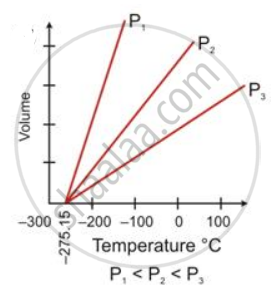Advertisements
Advertisements
प्रश्न
How did Charles's law lead to the concept of an absolute scale of temperature?
उत्तर
The temperature scale with its zero at -273°C and where each degree is equal to the degree on the Celsius scale is called the absolute scale of temperature.
The temperature of -273°C is called absolute zero. Theoretically, this is the lowest temperature which can never be reached. All molecular motion ceases at this temperature.
The temperature of -273°C is called absolute zero.
V = V° `((273 + "t")/273)`
Volume at - 273°C = V° `((273 - 273)/273) = 0`
APPEARS IN
संबंधित प्रश्न
Give the assumptions of the kinetic molecular theory.
State the law which is represented by the following graph:

Give reasons for the following:
Mountaineers carry oxygen cylinders with them.
State the following:
Ice point in absolute temperature
Calculate the final volume of a gas 'X' if the original pressure of the gas at STP is doubled and its temperature is increased three times.
2500 cm3 of hydrogen is taken at STP. The pressure of this gas is further increased by two and a half times (temperature remaining constant). What volume will hydrogen occupy now?
Give its
(i) graphical representation,
(ii) mathematical expression
(iii) significance
Correct the following statement:
The volume of a fixed mass of a gas is directly proportional to its temperature, pressure remaining constant.
At a given temperature the pressure of a gas reduces to 75% of its initial value and the volume increases by 40% of its initial value. Find this temperature if the initial temperature was -10°C.
Fill in the blank with the correct word, from the words in option:
If the temperature of a fixed mass of a gas is kept constant and the pressure is increased, the volume correspondingly _______.
